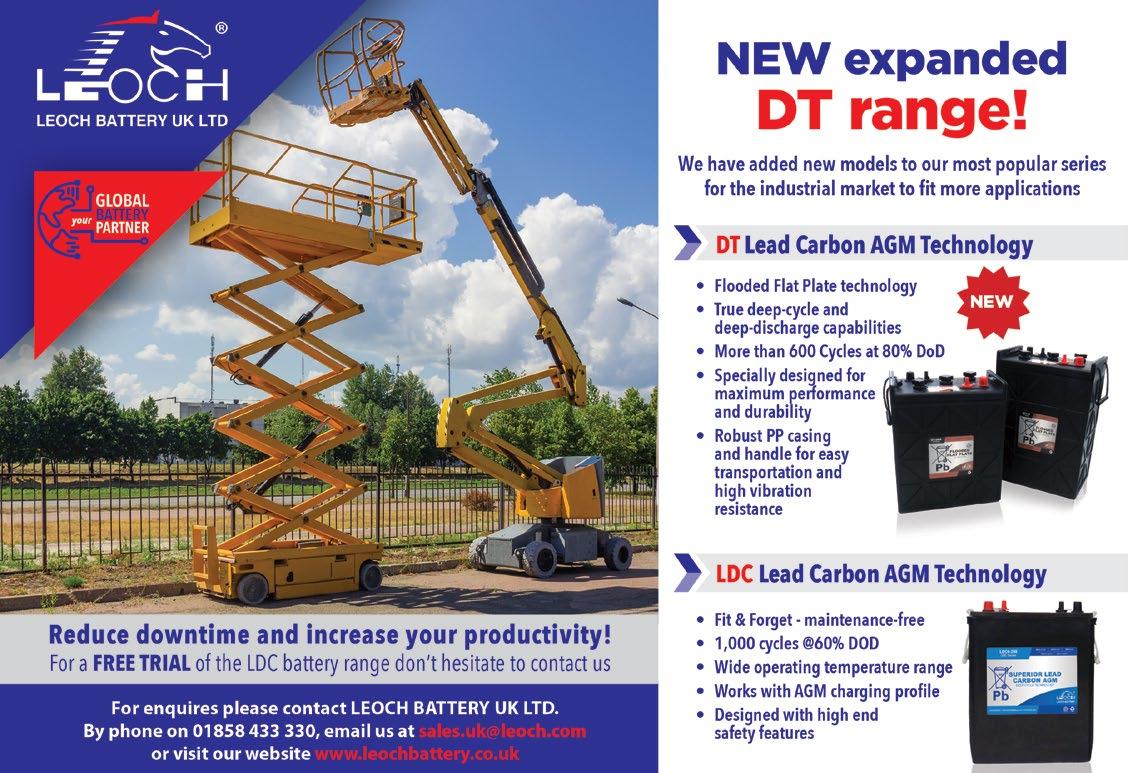
11 minute read
Power to the people
Power to the people
Growing environmental demands along with higher health and safety requirements and increasing pressure on costs means more companies than ever are looking at electric power alternatives to their internal combustion powered tools and equipment. And most of that interest is focused on battery powered solutions. We take a look at the constantly improving technology for use in cranes, telehandlers and aerial work platforms.

Almost every equipment manufacturer in the market has been ‘pressured’ into offering battery electric versions of its product line…but is it the ultimate solution?
Electric powered machines certainly address emissions and noise reduction at the point of use, but as we highlighted in our October issue, there is the growing problem in most countries with electric supply infrastructure, not to mention the lack of charging facilities in remote areas. This is causing more companies to look at alternatives, as well as higher capacity battery packs.
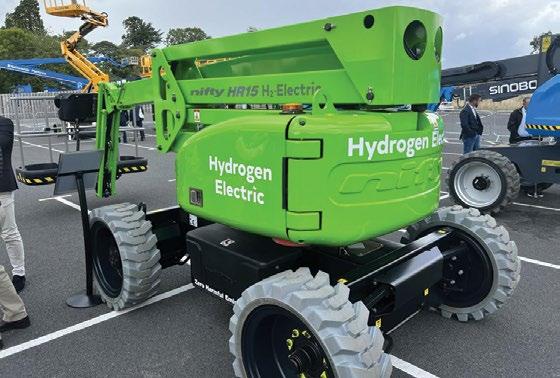
While the production of petrol and diesel engines will drop dramatically over the next 10 years, there is a growing interest in hydrogen powered engines, particularly for the larger equipment. Research suggests that hydrogen engines will gradually become a practical option over the next five years but then grow exponentially over the next 20 years. But this requires the generation of green hydrogen and the infrastructure to delivery it - much the same issue as electric charging points. While the development and adoption of hydrogen engines appears to be a simpler lower cost alternative, the operating cost is likely to become a limiting factor.
However, it is worth noting that many of these issues may be resolved or improved with the continued technological development surrounding hydrogen vehicles. At the same time the cost of producing green hydrogen should reduce significantly over time and, if it continues to fall at pace, hydrogen engined vehicles could become very competitive across a wider range of applications in the future.
Hydrogen Developments
There are several equipment companies currently developing hydrogen powered equipment. Late last year Niftylift revealed a prototype HR15 H2 Hydrogen Electric articulated boom lift powered by a hydrogen power cell capable of recharging the regular electric machine’s battery up to three times from one small replaceable tank or cylinder. At Conexpo next month JCB is set to unveil its new hydrogen combustion engine and has recently installed it into a 7.5 tonne Mercedes truck. Although the company claims to have developed the world’s first battery electric mini excavator we should not overlook the progress made in reducing emissions from diesel engines over the past 20 years or more. JCB’s latest diesel engines, for example, deliver a 97 percent reduction in NOx emissions since 1999 and a 98 percent reduction in particulates. They also emit 50 percent less CO2 compared with those manufactured in 2010.

Hydrogen flywheel genset
Another interesting development is the world’s first hydrogen generator set with integrated Flywheel Power Boost. In the C&A’s October issue (Vol 24. 6) we covered the electric motor powered Punch Flybrid Flywheel Power Boost which is already being used on many construction sites in dynamic applications including tower cranes, hoists, mastclimbers and pumps - resulting in sizeable real world fuel and emission savings.
The Hydrogen Genset uses a hydrogen engine developed by Punch Hydrocells and is based on a diesel engine already produced in high volume for other applications. An engine running on hydrogen has to be particularly robust against temperatures as well as vibrations. Furthermore, it is tolerant to low purity hydrogen, making this technology well suited to the generator set application which often operates in harsh environments.

The generator - developed with Italian company Tecnogen uses an ultra silent - just 55dBAFUSTEQ canopy, electric radiator with variable speed inverter, stainless steel residual silencer, motorised circuit breaker, battery isolator switch and forklift guides. Maximum output is 120kVA and overall size is 3.9 by 2.28 metres with an overall height of 1.2 metres. Having said all that hydrogen solutions are currently far and few between - so in the short term, battery power is still the go-to solution.
All-electric equipment
Since our last battery roundup a year ago manufacturers have continued to develop more all-electric cranes, work platforms and telehandlers. Some of the more notable include Böcker’s six tonne all-electric AK48e aluminium crane mounted on a 27 tonne, battery powered Mercedes eActros electric chassis which uses three lithium-ion battery packs for a range of around 300km between charges.
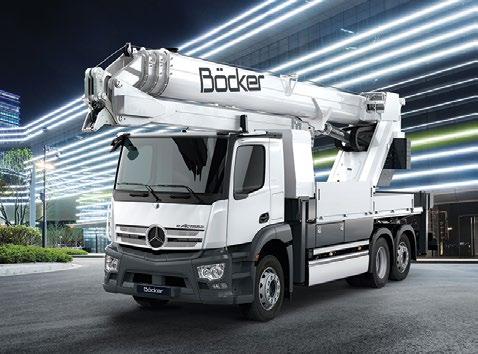
MEC has just introduced a new 10ft all-electric - zero oil - scissor lift, the Nano10-XD - similar to Dingli’s oil-free JCPT0507PA - which features a lithium ion battery pack for longer cycle times and faster recharging. Meanwhile the growth in battery powered boom lifts and Rough Terrain scissor lifts continues to grow, with Dingli now offering battery electric versions of its full range. On the telehandler front Faresin is leading the charge, having extended its full electric range from one to three models topped by the 17 metre/4,000kg 17.40 and the 17 metre/4,500kg 17.45. At the heart of the new telehandlers is a 45.36 kWh, 435V high voltage lithium-ion battery pack powering two electric motors - a 51kW for the drive transmission and a 23kW dedicated to the hydraulics.
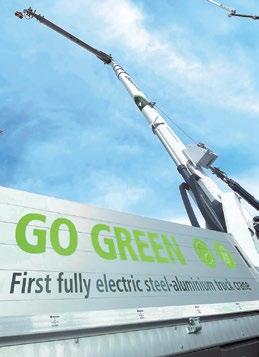
The new models can travel at speeds of 25kph during which the batteries are topped up by the regenerative braking system.
Manitou is also accelerating its battery powered range and recently acquired high tech lithium battery manufacturer and developer easyLi, and is working on a conversion kit for used telehandlers in partnership with French rental company Kiloutou. It is however keeping its options open and has installed a green hydrogen station in its test bed in Ancenis.
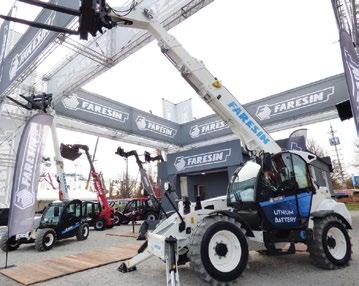
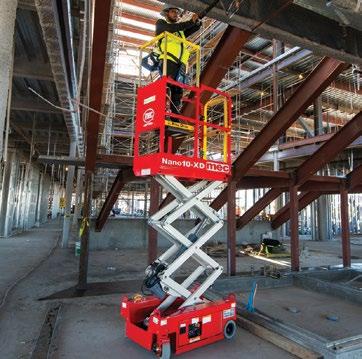

One fact that is always mentioned with 100 percent/all-electric machines (Zero Oil) is the high cost. It is now more than two years since JLG began production of its all-electric 19ft Davinci AE1932 scissor lift - the first in a new DaVinci range of lifts designed from the ground up to maximise the latest technology, eliminating all hydraulics by using AC electric drive motors and electro-mechanical steering and lift cylinders.
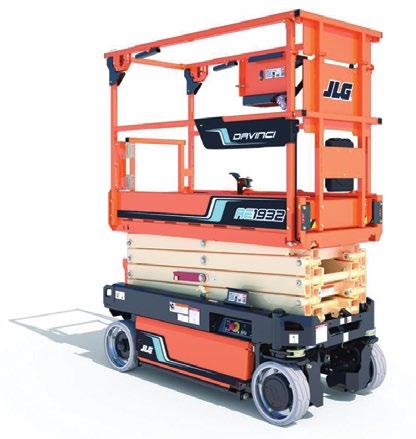

Economies of scale and automated production lines brings costs down over time. A case in point are the latest no oil machines from Dingli, its new range of larger wheeled ‘oil-free’ micro scissors - the 12ft JCPT0607PAH and 18ft JCPT0708PAH - also use electric motors or screw type actuators, but at a price that is said to be less than half the JLG machine.
As one of the comments in last month’s telehandler Rental Rate survey said: “We are seeing some demand for electric machines but trying to get the rate needed is not easy… people like the idea of clean and quiet but do not expect to pay for it.” Perhaps these newer, more cost-effective machines will mean reduced rental costs?
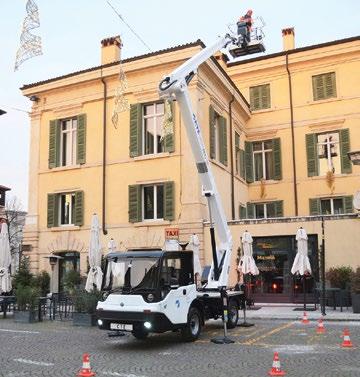
Batteries and chargers
We have covered batteries for many years including the feature last year - C&A Feb/ March 2022 - when we looked at battery developments from the first rechargeable lead acid battery invented in the mid 1800s - still the primary choice for many applications due to its low purchase cost and solid reliabilitythrough to a number of credible alternatives such AGM (Absorbed Glass Mat), Gel and most recently Lithium, with several manufacturers offering variations on the theme. Although more expensive these newer batteries have many advantages and claim a lower overall cost of ownership, helped by the fact that they are generally maintenance free. However, no matter how good the batteries supplied and fitted to a given piece of equipment, an appropriate charging system combined with an effective charge regime is the only way to exploit their full potential and for businesses to gain the maximum return on investment.

Well matched chargers
Selecting the right battery for the application, the budget and the results required is of course paramount, but so is ensuring that they are optimally matched to the right charger. This should, of course be a given on new equipment, but if you change the batteries to a different type, the importance of an appropriate battery charger cannot be over emphasised.
UK distributor Ecobat Battery promotes the fact that this is an important part of what it does. It is the distributor for Italian manufacturer SPE - S.P.E. Elettronica Industriale - which manufactures chargers for all types of batteries but is particularly noted for its development of high frequency (HF) charging technology in the 1990s which can, it says, produce significant savings compared to traditional chargers. The company continues to develop its product range in this area and now also has an app that allows businesses to calculate the savings that they can make by switching from a conventional to an HF charging system.
SPE produces charging systems for a variety of applications including forklifts, aerial work platforms and floor care equipment, as well as automotive applications. It also manufactures on-board and stand-alone Smart battery chargers for wet and gel traction batteries - both traditional and HF - with a fully programmable charging process providing standard and custom battery charging solutions.


Chargers that consume less power
One of the most practical, energy saving innovations in recent years has been the development of Ri Technology by charging equipment pioneer, Fronius. This allows operators to reduce the running costs of their fleet and prolong the lifespan of the batteries they use.
Whereas a normal 50Hz or HF charger will be selected with a specific output and will try to deliver that output to the battery during recharge, the Fronius Ri system continuously measures the internal resistance of the battery and adjusts its output from a defined amount, to whatever the battery can actually accept at that time. As a result of this process, far less heat is generated within the battery, which leads to less maintenance and provides a prolonged lifespan, but the key benefit is that no power is wasted generating heat, thus the electricity consumption compared to a normal charger, is greatly reduced.

A properly specified Fronius charger can cope with any battery voltage from 24 to 80 volts, and once connected, will self-select the appropriate output. It can charge wet lead-acid, Gel, AGM and even lithium-ion batteries, by adjusting to the built-in factory profiles. Coloured LEDs show the charge status, but an optional LED strip across the front panel provides a clear indication of status, even from a distance. Important data is simply displayed by scrolling through an easy to navigate menu system. Comprehensive charge data can be downloaded via the integral USB port and analysed using free software. The chargers are very compact for their output and capability and can be wall mounted using supplied brackets.
Space saving
The declining cost of lithium batteries and improved energy density versus other battery chemistries provide the benefit of higher efficiency, faster recharging, almost zero maintenance and a much longer lifespan, all of which helps improve the total cost of ownership. If you change your machines out every five years or so, the fact that the lithium ion battery pack might well go on for 10 years may not be of great concern. Most companies however that we have spoken to claim a pay back in year one, or at the very least two years. The fact that they are also more compact frees up space for other components creating more space for easier inspection and maintenance.
The advancements in charging technology has also paved the way for better suitability of mobile cranes, telehandlers and powered access equipment.
One example is Delta-Q’s XV3300 charger which features a 3.3 kW battery charger, a 500W DC-DC converter to power auxiliary devices on the machine, and an optional interface to EV charging stations, providing space and cost savings while eliminating the need for additional components. ■

